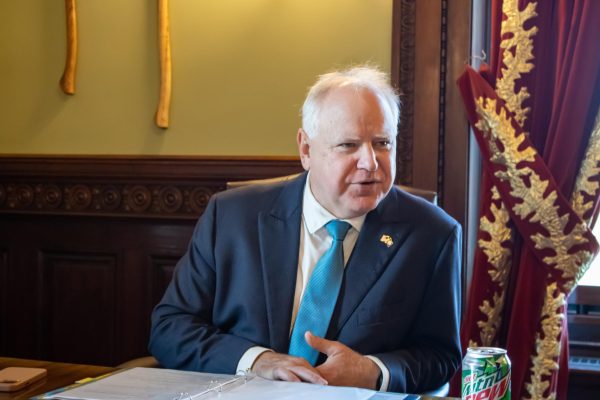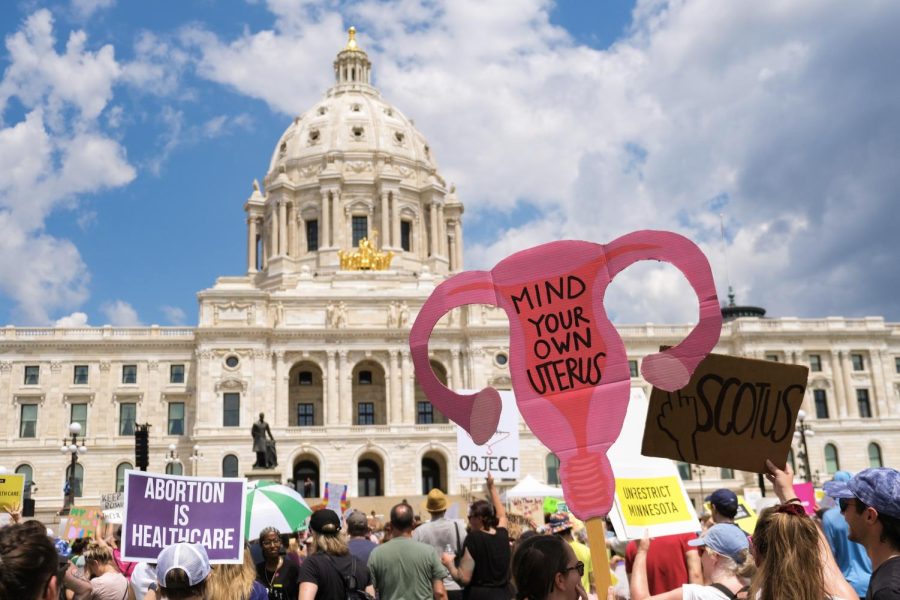WASHINGTON (AP) âÄî Congressional Democrats advanced budget outlines Wednesday that largely mirror President Barack Obama’s spending priorities while imposing marginal changes to tame ballooning deficits. A version put forward by the House Budget Committee foresees a $598 billion federal deficit after five years. And there would be a $1.2 trillion red-ink figure for the 2010 budget year, as opposed to $1.4 billion under Obama’s plan as scored by the Congressional Budget Office. Obama, after describing his tax and spending plan Tuesday night as essential for economic recovery, traveled to the Capitol for a meeting with Senate Democrats on the issue. Budget director Peter Orszag said the companion fiscal blueprints in the House and Senate would bolster administration efforts to give a higher priority to education and clean energy programs as well as taking into account Obama’s desire to overhaul health care. In a briefing for reporters in advance of Obama’s Hill visit, Orszag said the plans were “fully in line with the president’s key priorities.” Obama has said that he understands the process will necessitate considerable give and take, but that he doesn’t want to lose sight of the overall goals. He characterized them as “98 percent the same as the budget proposal the president sent up in February.” The most immediate impact of the budget outlines âÄî which are non-binding blueprints spelling out the parameters of subsequent implementing legislation âÄî is to impose a cap on the amount of money that can be doled out by the appropriating panels for the budget year starting Oct. 1. The House plan, unveiled by Budget Committee Chairman John Spratt Jr., D-S.C., would cut spending less âÄî just a $7 billion reduction from Obama’s domestic agency budgets for next year âÄî than would the companion Senate plan, which would curb such spending by $15 billion. On larger issues like taxes, health care and combating global warming, the congressional Democratic plans simply seek to punt difficult decisions into the future. The House measure also backs Obama’s plans to essentially eliminate the federal guaranteed student loan program, replacing such loans with direct loans made by the Department of Education. The proposal would be advanced on a fast-track under the plan, which the Congressional Budget Office estimates would save $92 billion over 10 years that could be used to fund other aid to students. Obama has been hearing increasingly vocal opposition to the blueprint he sent to Congress last month, however. Some of the opposition on spending, particularly, has come from moderate to conservative members of his own party. For their part, Republicans have almost universally assailed his spending plan as overly ambitious, saying that it would dump trillions in debt on future generations. While the budget plans that Democrats started pushing through Congress largely mirrored Obama’s blueprint, the plan advanced by Senate Democrats employs some sleight of hand âÄî such as assuming that Obama’s signature $400 tax cut for most workers and $800 for couples will not be renewed beyond 2010 âÄî to cut projected deficits to a more sustainable level. Orszag also revealed Wednesday that the administration was studying ways to simplify the U.S. tax code, seeking to close loopholes with an eye toward further budget savings. Meanwhile, House Minority Whip Eric Cantor charged that Obama’s budget is “so far out of the mainstream” that even members of Obama’s own party are reluctant to support it. The Virginia Republican said it puts too many taxes on businesses and said that policymakers must “provide relief to the job creators.” Both the House and Senate budget chairmen have been forced by worsening deficit estimates to scale back Obama’s requests for domestic programs, while deeply controversial revenues from his global warming initiative won’t be included either. Senate Budget Committee Chairman Kent Conrad, D-N.D., announced a budget blueprint Tuesday that would scrap Obama’s signature tax cut after 2010 while employing some sleight of hand to cut the annual budget deficit to a sustainable level. Conrad promises to reduce the deficit from a projected $1.7 trillion this year to a still-high $508 billion in 2014. Along the way, the Senate plan would have Obama’s “Making Work Pay” tax credit, delivering $400 tax cuts to most workers and $800 to couples, expire at the end of next year. Those tax cuts were included in Obama’s stimulus package. Democrats point out that Obama inherited an unprecedented fiscal mess caused by the recession and the taxpayer-financed bailout of Wall Street. Rather than retrenching, however, they still promise to award big budget increases to education and clean energy programs, while assuming Obama’s plans to overhaul the U.S. health care system advance. “The best way to bring our deficit down in the long run is … with a budget that leads to broad economic growth by moving from an era of borrow and spend to one where we save and invest,” Obama said in a Tuesday night news conference. It’s also becoming clear that Obama’s controversial global warming initiative has experienced a setback, as neither House nor Senate Democrats are directly incorporating into their budget plans Obama’s controversial “cap-and-trade” system for auctioning permits to emit greenhouse gases. Obama’s budget has ignited a firestorm on Capitol Hill, with Republicans assailing it for record spending and budget deficits. Democrats are generally supportive, though some have sticker shock over the deficit figures. Conrad’s plan was released in the wake of new Congressional Budget Office estimates that predicted Obama’s plan would produce alarming estimates of red ink âÄî $9.3 trillion over 10 years and a deficit of $749 billion in 2014. Obama’s budget promises a $570 billion deficit in that year, and to get below that figure Conrad was forced to make a series of difficult choices. Conrad said his budget makes room for Obama’s hopes to deliver health care to the uninsured. He said the plan would not add to the deficit over the long haul. In grappling with the deficit, Conrad would cut Obama’s proposed increases for next year for domestic agencies funded by lawmakers to growth of about $27 billion, or 6 percent. Over five years, the savings from Obama’s budget would be $160 billion. But Conrad also makes several shaky assumptions, especially that Congress will raise taxes by about $114 billion over 2013-14 to make sure middle-class taxpayers won’t get hit by the alternative minimum tax. He also saves $87 billion by promising Congress will come up with spending cuts or new revenues to avoid cuts in Medicare payments to doctors. Both problems have been fixed in recent years by using deficit dollars. Under Congress’ arcane procedures, the annual congressional budget resolution is a nonbinding measure that sets the terms for follow-up legislation. Neither budget includes Obama’s $250 billion set-aside for more bailouts of banks and other firms.
House, Senate budget outlines close to Obama plan
Budget director Peter Orszag said the companion fiscal blueprints in the House and Senate would bolster administration efforts.
Published March 25, 2009
0
More to Discover







